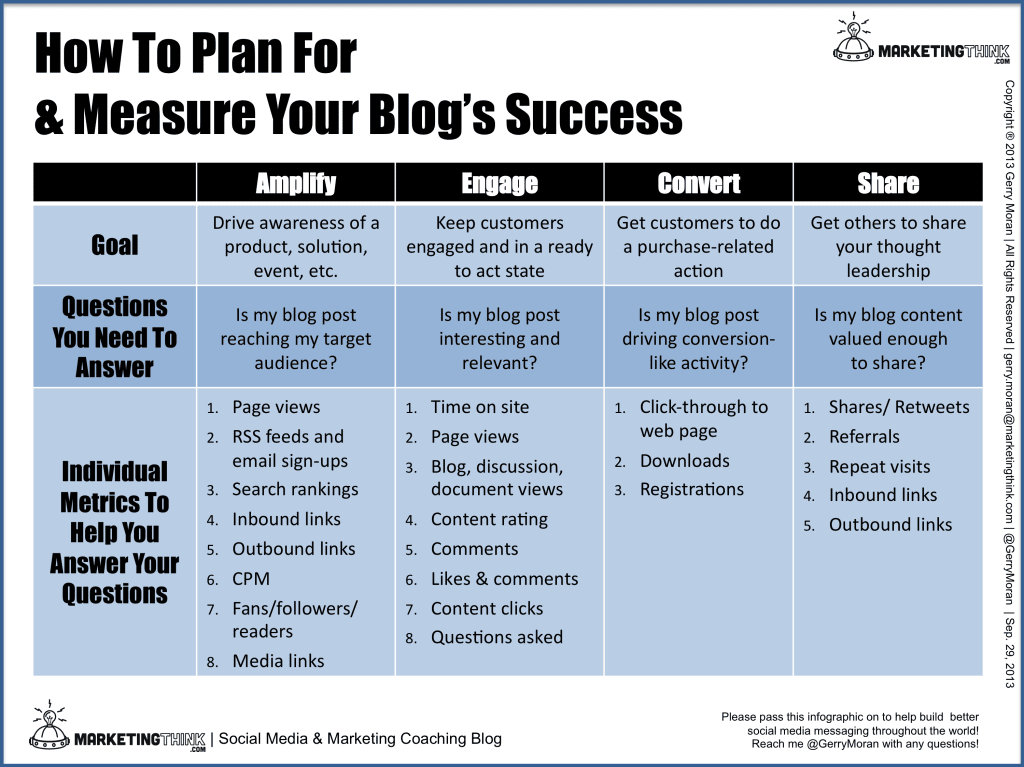You cannot have a successful blog unless you can measure it.
My first-grade teacher, Sister Christine, always said, “The best way to make sure that something was working was to set goals, ask questions about what you are trying to achieve with your goals, and then measure your performance.” Whether it was with a ruler, a calculator, or simple checklists, the good Sister also noted that there were many simple tools to help measure success. Sister Christine could be very inspiring with the ruler to encourage and measure our educational success, if you know what I mean!
These measurement lessons apply to measuring your blog performance. I took the good Sister’s inspiration and created a learning and measurement plan approach to social media and blogging when I worked with several award-winning advertising agencies. It was a great tool to help our clients understand the goals, the questions they should be asking to support the goals, and the measurements they should be made to learn, understand and optimize performance.
How To Measure Blog Success

It is key for bloggers and marketers to be able to measure the right activity to help judge its performance and make content and platform changes help reach the right audience with the right message.
Key Blog Metrics to Measure Success
1. Increase awareness with your blog
Use your blog to amplify the awareness of your product, service, or event. To help you understand if your blog is attaining this goal, you need to ask the question, “Is my blog post reaching my target audience?” You can help to answer this question by paying attention to these key blogging metrics:
- Page views
- RSS feeds and email sign-ups
- Search rankings
- Inbound links
- Outbound links
- CPM
- Fans/followers/readers
- Media links
2. Keep your customers engaged with your brand
Use your blog to keep customers informed, engaged, and in a ready to activate state. Answering the question, “Is my blog post interesting and relevant?” You can measure the interest and relevancy level by paying attention to these metrics:
- Time on site
- Page views
- Blog, discussion, document views
- Content rating
- Comments
- Likes & comments
- Content clicks
- Questions asked
3. Drive conversion with your blog
When it comes to making money for your business, a blog can help drive sales or sales-related activity. It can drive registration or any other action that moves customers closer to a sale. So, a question that you need to be asking yourself is, “Is my blog driving conversion-related activity?” Important activity to measure is:
- Click-through to the web page
- Downloads
- Registrations
4. Get your thought leadership content
Getting to people to share and advocate your content is the last key goal. You could classify this sharing activity as engagement; however, it’s important to create content that gets socially shared. You should ask yourself the question’ “Is my content valued enough to be shared by the reader?” You can answer these questions with supporting activity that measures:
- Shares/ Retweets
- Referrals
- Repeat visits
- Inbound links
- Outbound links
Do you have another way to measure your blog performance? If so, please share below. Or, contact me at gerry@marketingthink.com.
Now back to my first-grade teacher, Sister Christine, who had two different ways to use a measuring tool; first, using her ruler to determine if there was any measurable progress and then using that same ruler to bang on my knuckles when I wasn’t writing fast enough! Now, back to my next blog post … “Must …. Write …. Faster … Or …. Sister …. Christine … Will … Use … Her …. Ruler … For …. Some …. Something …. Other … Than …. Measuring”. Ouch!

